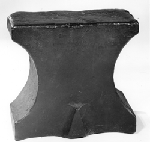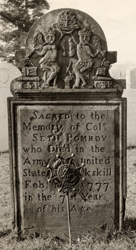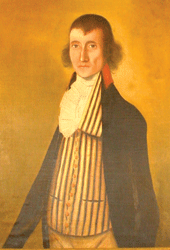
Bridge Street Cemetery Northampton Architecture Historic Markers 
|


The Pomeroy Family
 |
| This anvil, now at Historic Northampton Museum, belonged to Northampton’s first blacksmith, Medad Pomeroy. |
The Pomeroy family was among Northampton’s earliest and most distinguished families. Medad Pomeroy came to Northampton in 1660 because the town was in need of a blacksmith. He received tools and land in return for practicing his trade in the community. There followed several generations of blacksmiths, each learning the trade from their father.
 |
| This marker memorializes Seth Pomeroy, who fought in the French and Indian wars and at Bunker Hill in the American Revolution. |
Seth Pomeroy, Medad’s grandson, inherited the trade from his father, Ebenezer. Seth Pomeroy was not only a superb gunsmith, but a distinguished military leader as well. He was commissioned as Captain in the 3rd company of Snowshoe Men in 1732 and as Major in King George's War, participating in the capture of Louisbourg. As a Colonel in French and Indian War, he took part in the battle of Lake George. He was a delegate from Northampton to the First and Second Provincial Congresses and was in charge of three companies of Hampshire County
 |
| Aashel Pomeroy was a popular and prosperous innkeeper in the early 19th century. |
Of Seth Pomeroy’s children, Quartus became the town blacksmith, Lemuel was widely known as a gunsmith and Asahel, the youngest son, opened the town’s finest tavern and inn, a celebrated stop at the midpoint of the Boston and Albany stage route. Pomeroy descendents opened the new territories of upper New York state and Ohio after the Revolution. The stone monument to their memory, standing beyond, near Bridge Street, is a replica of the original Pomeroy anvil now housed at Historic Northampton Museum.
Contents Copyright 2025. Historic Northampton.